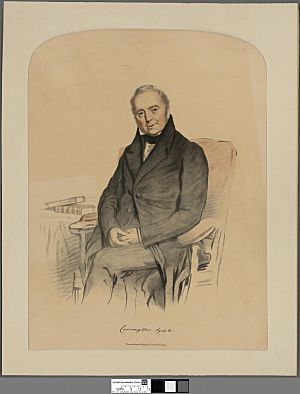Robert Smith, 1st Baron Carrington facts for kids
Quick facts for kids
The Lord Carrington
FRS FSA
|
|
|---|---|
 |
|
| Member of Parliament for Nottingham |
|
| In office 9 February 1779 – 20 October 1797 |
|
| Preceded by | Abel Smith |
| Succeeded by | John Borlase Warren |
| Member of the House of Lords Lord Temporal |
|
| In office 20 October 1797 – 18 September 1838 Hereditary peerage |
|
| Preceded by | Peerage created |
| Succeeded by | The 2nd Baron Carrington |
| Personal details | |
| Born | 22 January 1752 |
| Died | 18 September 1838 (aged 86) |
| Spouses | Anne Boldero-Barnard (died 1827) Charlotte Hudson |
| Children | 6, including Robert |
| Parents | Abel Smith Mary Bird |
Robert Smith, 1st Baron Carrington (born January 22, 1752 – died September 18, 1838) was an important British banker and politician. He served in the House of Commons, which is a part of the British Parliament, from 1779 to 1797. After this, he was given a special title called a "peerage," which meant he became a Baron.
Contents
Who Was Robert Smith?
Robert Smith was the third son of Abel Smith and Mary Bird. His family was well-known in banking. His grandfather, also named Abel Smith, started Smith's Bank in Nottingham. This bank became very successful.
Robert Smith married Anne Boldero-Barnard in 1780. They had one son and five daughters together.
Robert Smith's Political Career
Robert Smith became a Member of Parliament (MP) for Nottingham in 1779. He took over the role after his older brother, Abel, passed away. An MP is someone elected to represent people in the House of Commons, where laws are made.
He was re-elected several times for Nottingham: in 1780, 1784, 1790, and 1796. This shows he was a popular choice among the voters in his area.
Becoming a Baron
In 1796, Robert Smith was given the title of Baron Carrington. This was a special honor, and it meant he became a member of the Peerage of Ireland. He received this title partly because he helped the Prime Minister, William Pitt the Younger, with his personal money problems.
The next year, in 1797, he was given another title: Baron Carrington, of Upton in the County of Nottingham. This new title was part of the Peerage of Great Britain. Because he became a Baron, he had to leave his seat in the House of Commons. His place as an MP for Nottingham was then taken by Sir John Borlase Warren.
Later Life and Achievements
After leaving the House of Commons, Robert Smith continued to be an important figure. In 1800, he was chosen as a Fellow of the Royal Society. This is a very respected group for people who have done great things in science. In 1812, he also became a Fellow of the Society of Antiquaries, which focuses on history and old artifacts.
From 1802 until he passed away, he was the Captain of Deal Castle. This was an important role, overseeing a historic castle.
Robert Smith and Slavery Compensation
Robert Smith was involved in the system of slavery. After the Slavery Abolition Act 1833 was passed, which ended slavery in most British territories, the British government paid money to former slave owners. This was done through the Slave Compensation Act 1837.
Robert Smith received a payment because he had owned 268 enslaved people in Jamaica. This payment was a significant amount of money at the time. The money for these payments came from a large loan taken out by the British government, which was eventually paid back by British taxpayers.
Robert Smith's Family Life
Robert Smith's first wife, Anne, passed away in 1827. In 1836, when he was 83 years old, he married his second wife, Charlotte Hudson. He passed away in September 1838 at the age of 86.
His son, Robert, inherited his father's titles and became the 2nd Baron Carrington. The next year, his son changed his last name to Carrington.
Robert Smith's Children
Robert Smith had six children with his first wife, Anne Boldero-Barnard. They were:
- Hon. Catherine Lucy Smith
- Hon. Hester Frances Smith
- Hon. Emily Smith
- Hon. Charlotte Elizabeth Smith
- Hon. Harriet Smith
- Hon. Robert John Smith, who later became the 2nd Baron Carrington.

